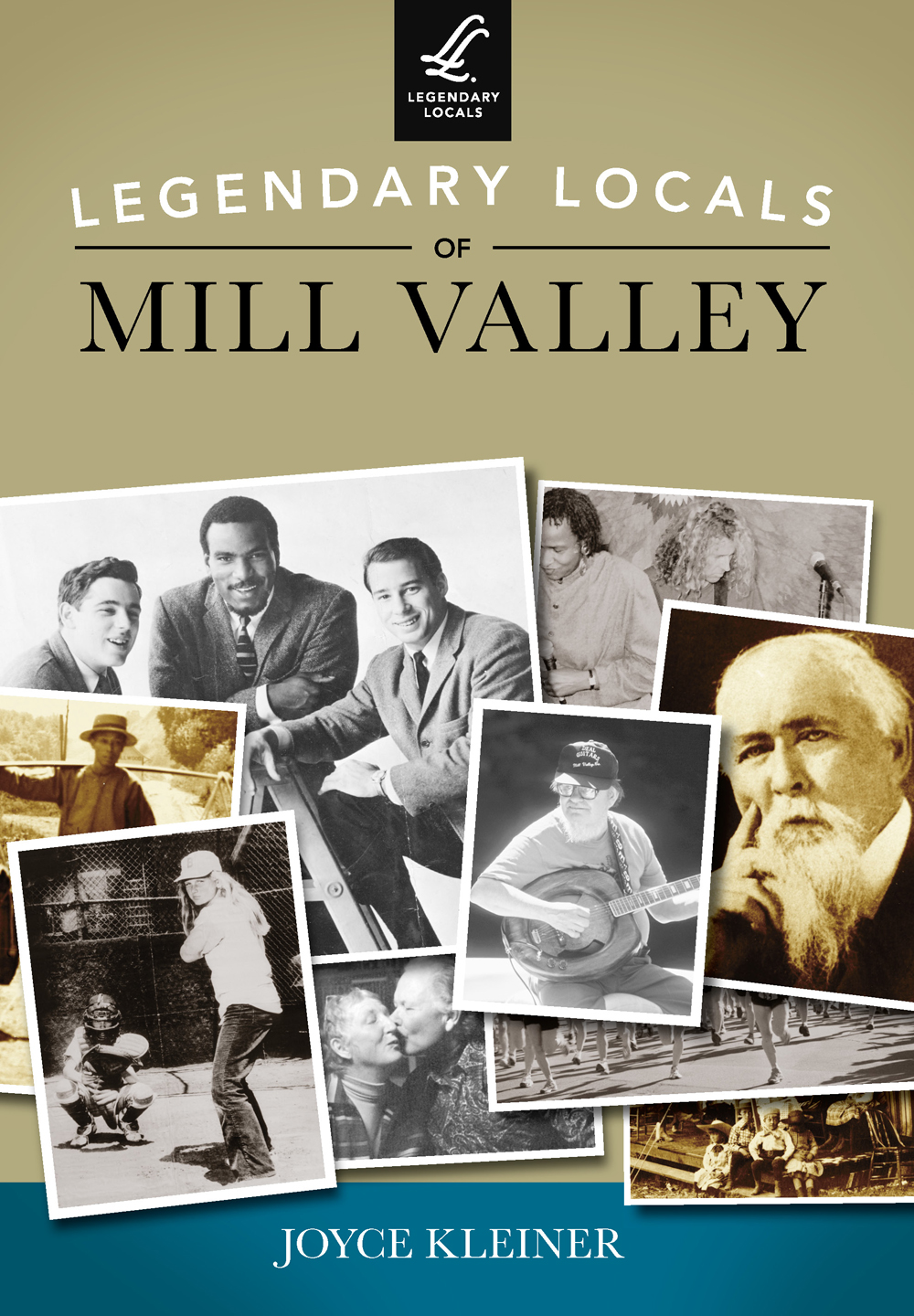
LEGENDARY LOCALS
OF
MILL VALLEY
CALIFORNIA


Greater Mill Valley
This map shows the borders of the incorporated City of Mill Valley as well as the border of Greater Mill Valleythe entire area with a Mill Valley, CA 94941 address. The town of Mill Valley is almost always considered to be the greater definition. (Author collection.)
: Panoramic Views of Mill Valley
These side-by-side images show the same panoramic vista of Mill Valley in different eras. The c. 1903 postcard features the The Crookedest Railroad in the World, which wove its way to the top of Mount Tamalpais until 1929. The view 110 years later includes significantly more trees and homes, a bridge across an inlet off Richardson Bay, and a fog-enclosed skyline of San Francisco. (Author collection.)
LEGENDARY LOCALS
OF
MILL VALLEY
CALIFORNIA
JOYCE KLEINER

Copyright 2014 by Joyce Kleiner
ISBN 978-1-4671-0128-8
Ebook ISBN 9781439645352
Legendary Locals is an imprint of Arcadia Publishing
Charleston, South Carolina
Library of Congress Control Number: 2013946560
For all general information, please contact Arcadia Publishing:
Telephone 843-853-2070
Fax 843-853-0044
E-mail
For customer service and orders:
Toll-Free 1-888-313-2665
Visit us on the Internet at www.arcadiapublishing.com
Dedication
To my husband, Robert, and son, Jake, with gratitude for their patience and support And to Deborah Lichtman, my mentor and my friend
On the Front Cover: Clockwise from top left:
Jon Fromer, Elbert Robinson, and Dave Fromer, 1960s folk trio Jonathan, David, and Elbert (Courtesy of Jacki Fromer; see ).
On the Back Cover: From left to right:
Katharine and Ned Mill and the staff of the Mill Valley Record (Courtesy of Suki Hill; see ).
CONTENTS
ACKNOWLEDGMENTS
When I was invited to write this book, I felt both excited and intimidated. How could I tell the complete story of all Mill Valleys legendary locals? Of course, I couldnt. But I could create a scrapbook of moments to suggest the richness and diversity of the people who have made Mill Valley the town that it is. In my research, I met many of those people. They generously gave of their time to tell me their stories, or the stories of those who are gone. These conversations took place in cottages, apartment buildings, stately Craftsman homes, and more than a couple of converted barns, allowing me a greater understanding of my community.
I appreciate every person who shared a tale or trusted me with an irreplaceable document or photograph. But a few peopleincluding members of Mill Valleys Historical Societydeserve special recognition for clarifying important events or complicated topics for me. They are Andy Berman, Betsey Cutler, Doug Ferguson, Bob Flasher, Kathleen Foote, John Goddard, Betty Goerke, John Leonard, Cindy McCauley, Elizabeth McKee, Steve McNamara, Joan Murray, Mary OLeary, Chuck Oldenberg, Trubee Schock, Anne Solem, Dick Spotswood, Kim Strub, Jean Symmes, Abby Wasserman, and Ryan White.
Many thanks to the Anne T. Kent California Room, Marin County Free Library; the Bancroft Library, University of California, Berkeley; and the Marin History Museum for providing archival photographs, and to the professional photographers who allowed me to use their imagesparticularly Suki Hill, whose extraordinary talent for capturing the essence of Mill Valleys people with her camera cannot be overemphasized. Those who have provided images are acknowledged in the courtesy line following each caption. Photographs taken by me as well as images from my personal collection are noted as author collection.
Thanks, also, to Matt Schriock of Image Flow in Mill Valley for helping me gain control of my camera and my collection of images. And finally, my deepest gratitude goes to Deborah Lichtman for her guidance and support throughout the writing of this book.
While I have made every effort to achieve accuracy here, there still may be disputed details. Any errors in this book are my responsibility and are in no way a reflection on those whom I have consulted or interviewed.
INTRODUCTION
The story of Mill Valley begins with Mount Tamalpais, standing more than 2,500 feet above sea level and separating Mill Valley from the Pacific Ocean. Long before the first Coast Miwoks arrived in the area, the mountain shaded the canyons below it and served as a buffer from the coastal wind and fog. The Miwoks did not live on the mountain itself, but Mount Tamalpais was surely a symbol to them, as it would be for those who came later.
After the first white man arrived in the area, the story of Mill Valleys early residents describes a shifting control of the land. Three separate countries governed the area between the 1700s and the turn of the 20th century: Spain, Mexico, and the United States. During those early years, the area was molded by the impact of nearby missions, a Mexican land grant system called ranchos, gentleman farmers, tenant-ranchers, land speculators, and entrepreneurs. For some, fortunes would be lost. For others, a new and better life would begin.
Location has blessed Mill Valley in ways no one could have predicted in those early years. To the south of what is now Mill Valleyin San Francisco, and to the north of itin San Rafael, large missions were built, providing the foundations for future towns. But the area just north of the growing harbor town of Sausalito stayed relatively undisturbed. Its position on the north side of the then bridgeless bay insulated it from changes taking place elsewhere in the state right up to the 20th century.
By 1890, San Francisco was a sophisticated metropolis. Many city dwellers took a ferry across the bay to escapenot the heat and humidity of the big citybut the bone-chilling fog. They also enjoyed the splendors of hiking on Mount Tamalpais and the joys of country life, whether as guests at the fashionable Blithedale Hotel or in more modest accommodations.
When the opportunity to own a parcel of this paradise presented itself in the form of a land auction in 1890, many San Franciscans took advantage of the opportunity. Most buyers built modest summer cottages; some built vacation estates. And a hardy few settled in to build a new life in full-time homes. Among them were immigrants from the Portuguese Azore Islands, who had formerly been tenant-farmers on the land. Mill Valley entered the 20th century as a relatively pristine and rural landscape.
Contrary to its name, Mill Valley never served as a mill town. There is no evidence that John Reeds mill, built around 1837, did much more than hone timber for Reeds relatively modest lumber needs and those of a few neighbors. Mill Valley was not a logging town for its residents, either. Outsiders logged its vast forest of virgin redwood trees and floated the logs to Sausalito, where they were either milled or carried on to other parts. And though the immigrants from the Azores began what remains a tradition of dairy ranching in Marin County, Mill Valley was never a farming or a ranching town on a significant scale. Mill Valley was an outpost. Later, it was a retreat. Eventually, it became a residential community.
Next page















